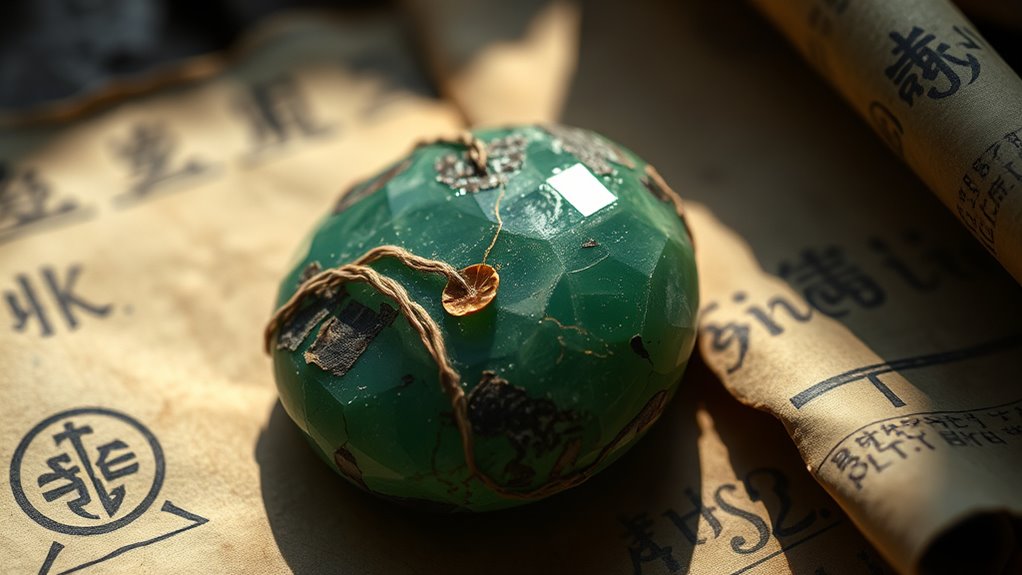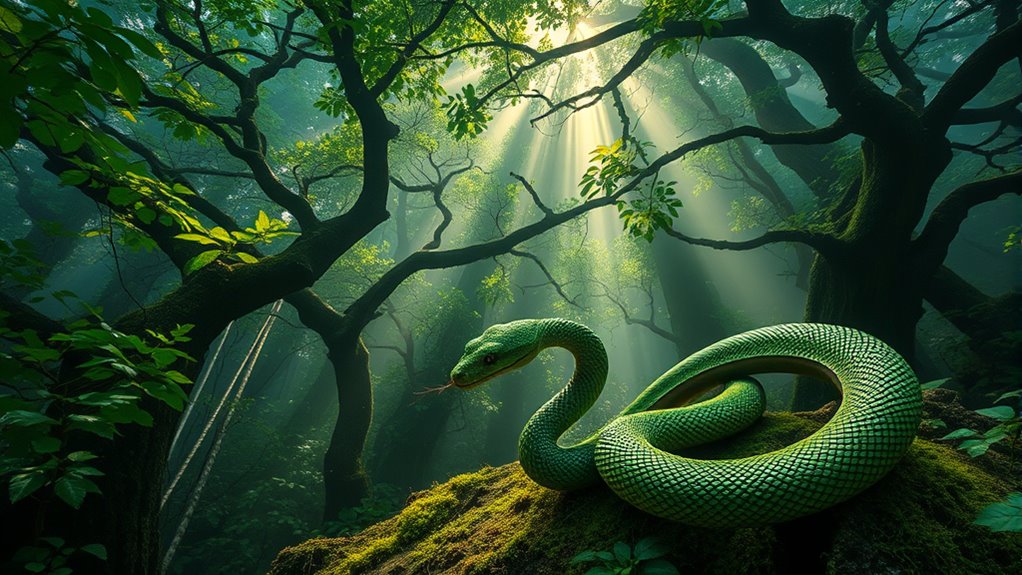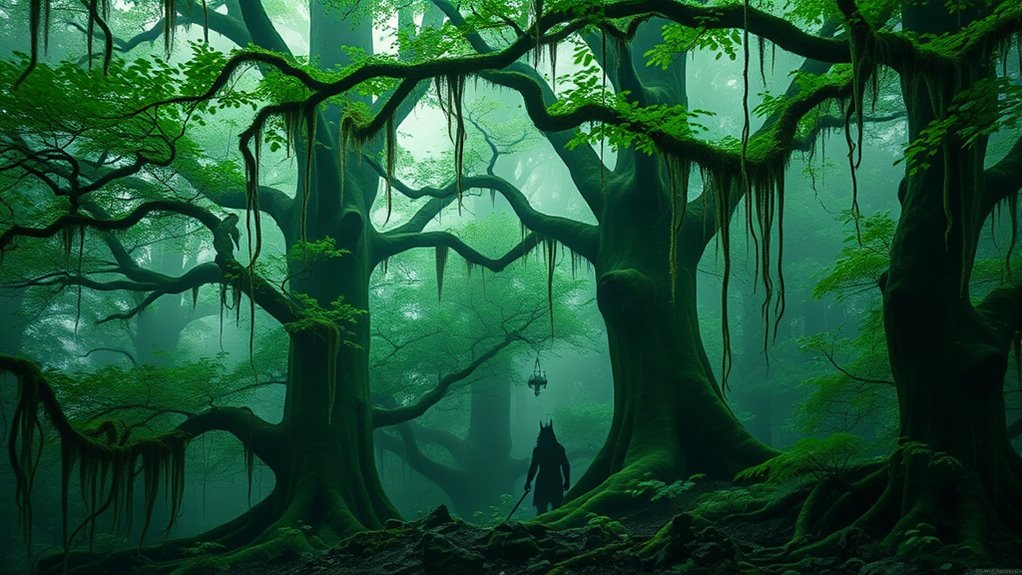In many cultures, green is feared because it symbolizes both life and danger. It’s connected to hidden spiritual energies and mystical domains, but also warns of toxicity, death, and betrayal. Green’s dual nature reflects its role as a symbol of growth and peril, making it a complex and sometimes ominous color. If you keep exploring, you’ll discover why this vibrant hue has held such a mysterious and cautionary place in mythology across the ages.
Key Takeaways
- Green symbolized both growth and danger, embodying the paradoxical nature of life, death, and renewal in mythological contexts.
- Its association with poisonous plants fostered fears of toxicity, linking green to peril and death across ancient cultures.
- Green’s connection to spiritual realms and mystical energies made it both revered and mistrusted as a gateway to the supernatural.
- Cultural taboos and superstitions cast green as a color of envy, betrayal, or ill fortune, fueling apprehension and caution.
- The dual symbolism of green as protective yet potentially deceptive led to its complex, often fearful role in mythology.
Green and the Supernatural: Connecting to the Otherworld

Green has long been associated with the supernatural and the mystical sphere beyond our everyday world. It’s part of nature’s palette that symbolizes growth, renewal, and the unseen energies connecting us to spiritual realms. In many cultures, green is more than just a color—it’s a symbol of spiritual symbolism that links humans to the divine or the otherworldly. You might notice how shamans and mystics often wear green or incorporate it into sacred rituals, believing it opens pathways to unseen forces. Its vibrant hue evokes the lushness of enchanted forests and verdant landscapes, which serve as gateways to mystical experiences. This deep connection to nature’s palette makes green a powerful color representing the mysterious and spiritual dimension beyond our tangible reality.
Poison and Peril: The Dark Side of Green in Ancient Cultures

While green’s association with nature and spiritual insight is well-known, it also harbored a darker reputation in ancient cultures. You might not realize, but this vibrant color symbolized danger, especially through poisonous plants that could bring death or illness. Ancient peoples feared green because it represented both the deadly and the protective, as seen in the legendary green warriors who wielded toxic herbs. These warriors used poisonous plants as weapons or defenses, blending bravery with peril. Green’s dual nature made it a symbol of both life and death, a reminder that beauty often concealed danger. Additionally, the toxicity of certain green plants contributed to its ominous reputation, reinforcing the idea that not all green things were safe to trust.
Green as a Symbol of Death and Rebirth in Mythology

In many mythologies, the color green embodies both death and rebirth, symbolizing the cycle of life, decay, and renewal. You see this in stories where green signifies a symbolic transformation—death giving way to new life. In rituals, green often holds ritual significance, representing the passage from one state to another. For example, ancient cultures used green plants in ceremonies to honor the dead and invoke rebirth. This dual symbolism reflects nature’s cycles of decay and regeneration, reminding you that death isn’t final but a crucial part of renewal. Green’s association with both endings and beginnings makes it a powerful color in mythological narratives, emphasizing the enduring hope of rebirth amid loss. Additionally, the symbolic significance of green extends to its use in various cultural rituals, further reinforcing its importance in the cycle of death and rebirth.
The Ambiguous Nature of Green: From Growth to Danger

The color green carries a paradoxical reputation in mythology, symbolizing both significance and danger. Its symbolic ambiguity reflects how different cultures perceive it—sometimes as life and renewal, other times as threat or poison. Green’s association with growth and fertility highlights its positive aspects, but its darker side warns of toxicity and deception. You’ll find that cultural perceptions shape these contrasting views, making green a complex symbol. Interestingly, in some cultures, green has been used to ward off evil spirits, underscoring its dual role as both protective and menacing cultural perceptions.
Cultural Taboos and Green: Forbidden Colors and Superstitions

Green’s complex symbolism extends beyond mythology into cultural taboos and superstitions that mark it as a forbidden or ominous color. In many cultures, green is associated with purity and renewal, but it also signals danger or betrayal. For example, in some societies, wearing green can be linked to superstition, warning against envy or ill fortune. Conversely, green’s connection to wealth often makes it a symbol of prosperity, yet this can also invite greed or corruption. In certain traditions, green is considered a forbidden color, avoided in rituals or worn only under specific circumstances. These taboos reveal how green can embody conflicting meanings—representing both hope and caution—shaping cultural attitudes and superstitions around the color.
Frequently Asked Questions
How Did Green Become Associated With Evil Across Different Mythologies?
You might wonder how green became linked to mythological evil. In many cultures, green symbolism associated it with danger, envy, or illness, which fueled fears. For example, in Western myths, green often represented jealousy or treachery, while in others, it signified decay or poison. These associations created a perception of green as an ominous color, reinforcing its connection to mythological evil across different societies.
Are There Any Cultures That Revered Green as a Sacred Color?
Green symbolism holds a sacred place in many cultures, defying fears and embracing reverence. You’ll find that some societies, like the ancient Egyptians, revered green as a divine color representing fertility, rebirth, and eternal life. Cultural perceptions of green vary widely; in others, it’s a symbol of nature’s vitality and spiritual growth. Far from being feared, green’s rich symbolism often signifies hope, renewal, and sacredness across diverse traditions.
What Role Did Green Play in Ancient Religious Rituals?
You might find that green played a crucial role in ancient religious rituals through symbolic plantings and ritual color significance. Cultures often used green to represent fertility, renewal, or divine life, incorporating sacred plants into ceremonies. These rituals emphasized green’s connection to growth and rebirth, reinforcing its spiritual importance. By using green intentionally, people expressed reverence for nature’s power and sought to invoke blessings or protection from deities.
How Has the Perception of Green Changed Over Time Globally?
Did you know that the perception of green has shifted dramatically over time? Once feared as a symbolic color associated with danger, envy, or even decay, green gradually gained positive cultural significance. Today, it symbolizes growth, renewal, and environmental awareness. This cultural evolution reflects how societies reinterpret colors, transforming their meanings based on changing beliefs, values, and experiences—making green a vibrant example of color’s dynamic role in human history.
Are There Modern Myths Linking Green to Supernatural Phenomena?
You might find that modern folklore sometimes links green to supernatural symbolism, such as fairies or ghosts associated with lush forests. These stories often portray green as a color of mystery and enchantment, fueling beliefs in supernatural phenomena. While not as widespread as ancient fears, these myths keep alive the idea that green holds a special, sometimes eerie, significance in contemporary supernatural tales.
Conclusion
You might find it interesting that, despite green’s association with life and renewal, many cultures also saw it as dangerous or forbidden—almost like an unexpected twist in a story. Maybe it’s no coincidence that green’s dual nature reflects how life itself can be both beautiful and perilous. So next time you see a vibrant green, remember, it’s been whispering stories of both growth and warning for centuries—just waiting for you to notice.









